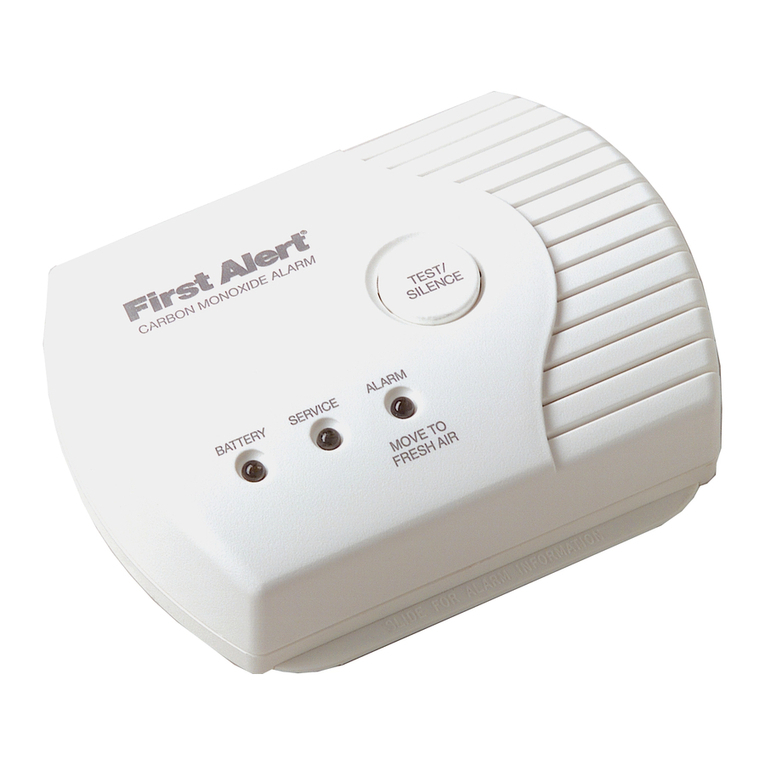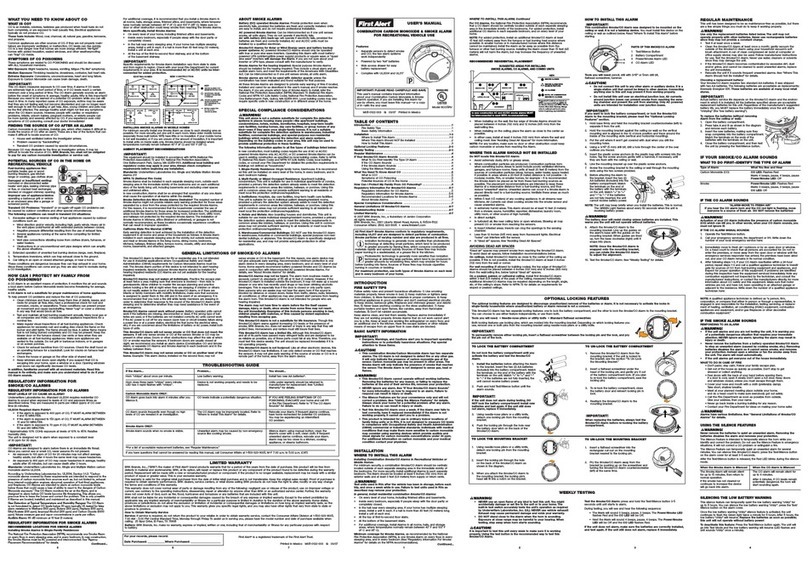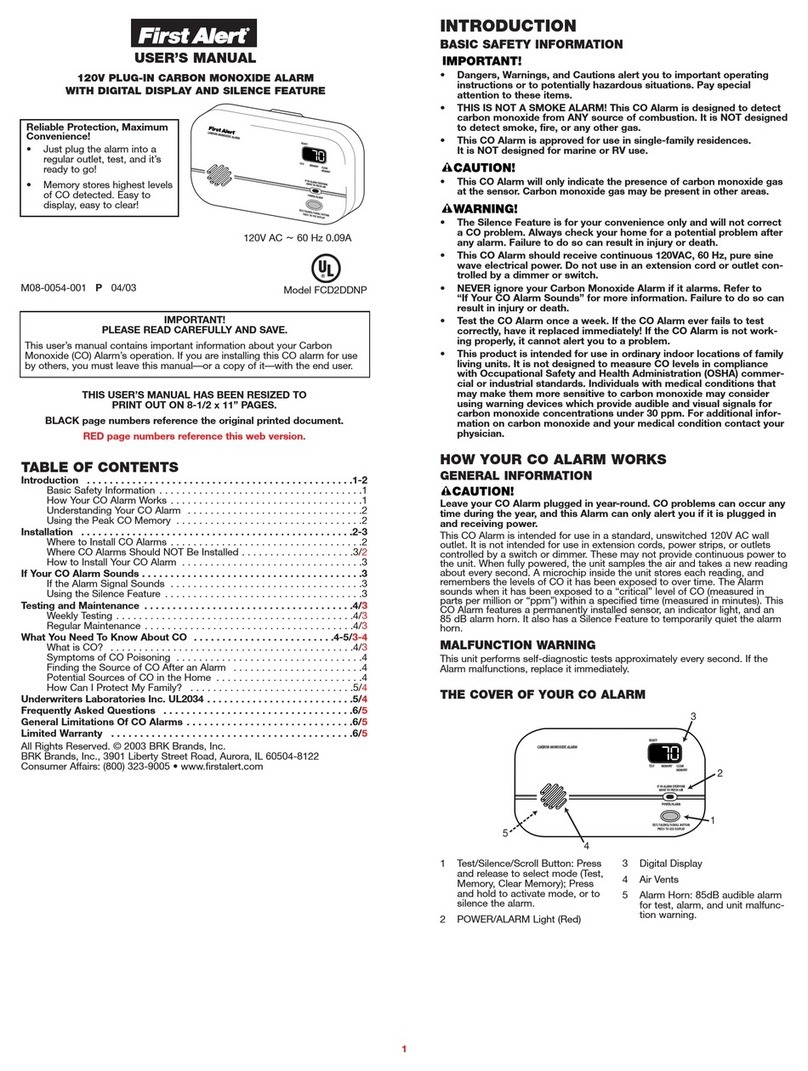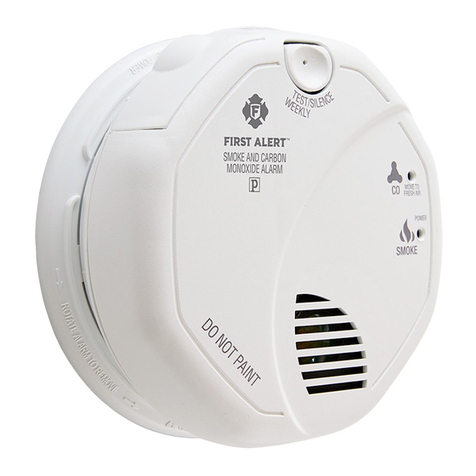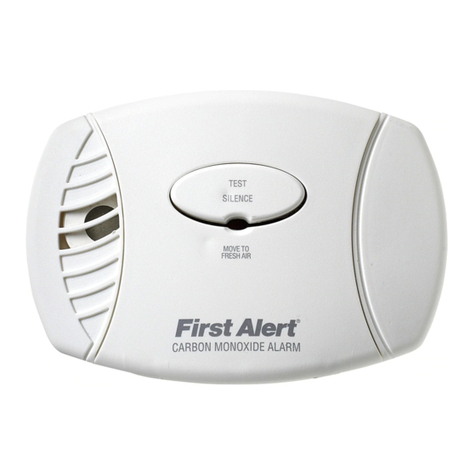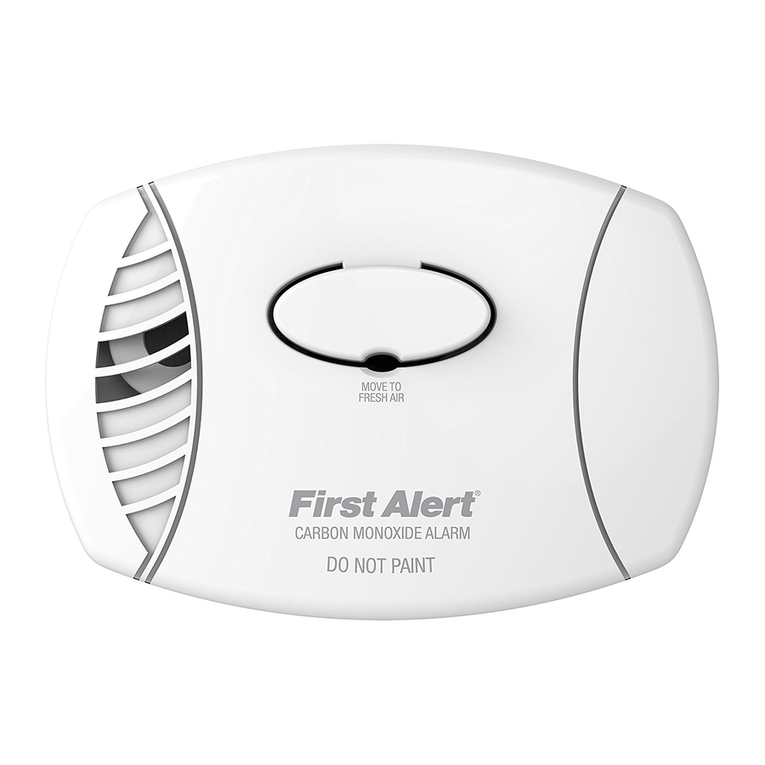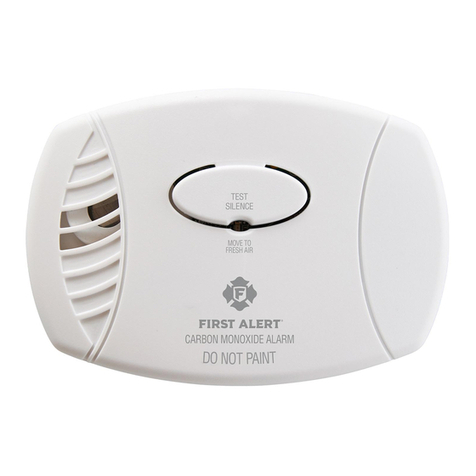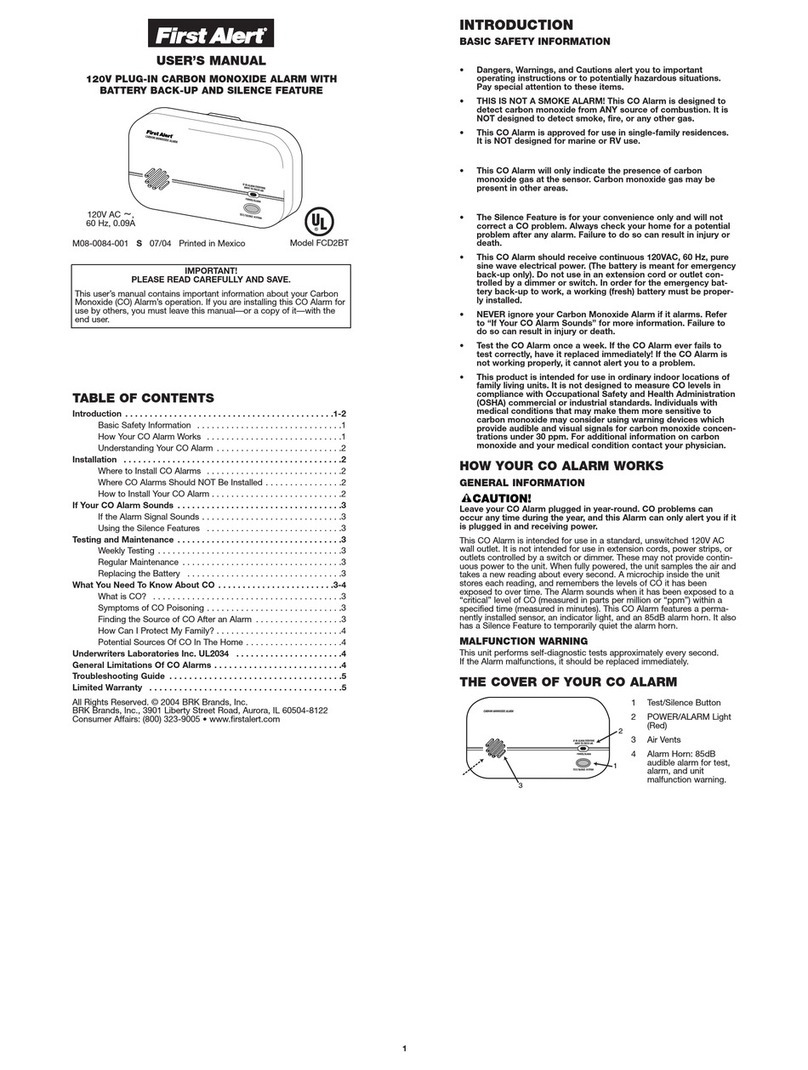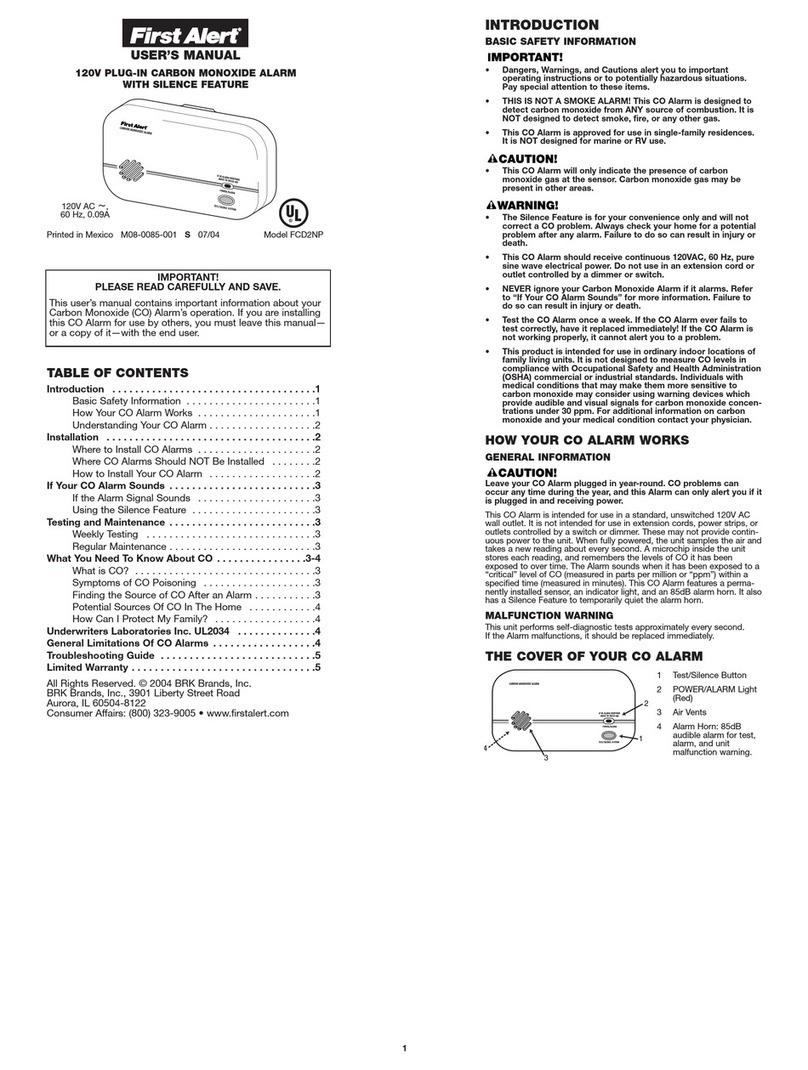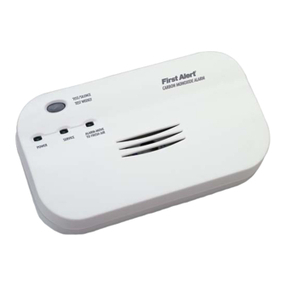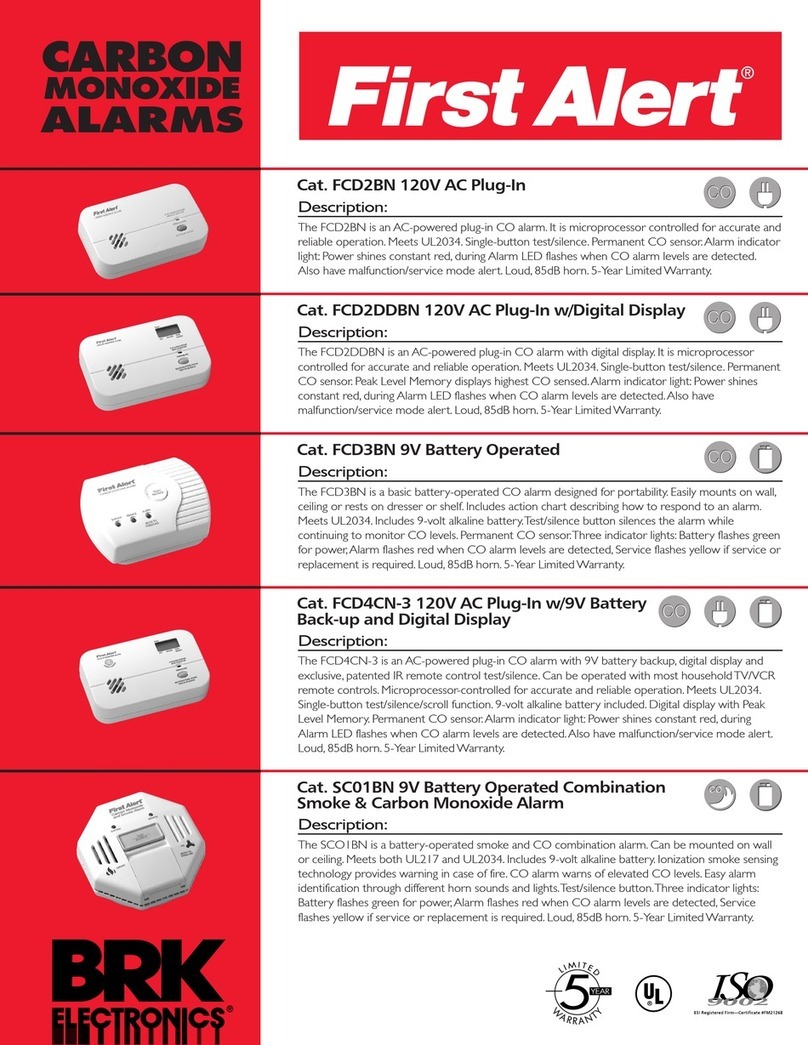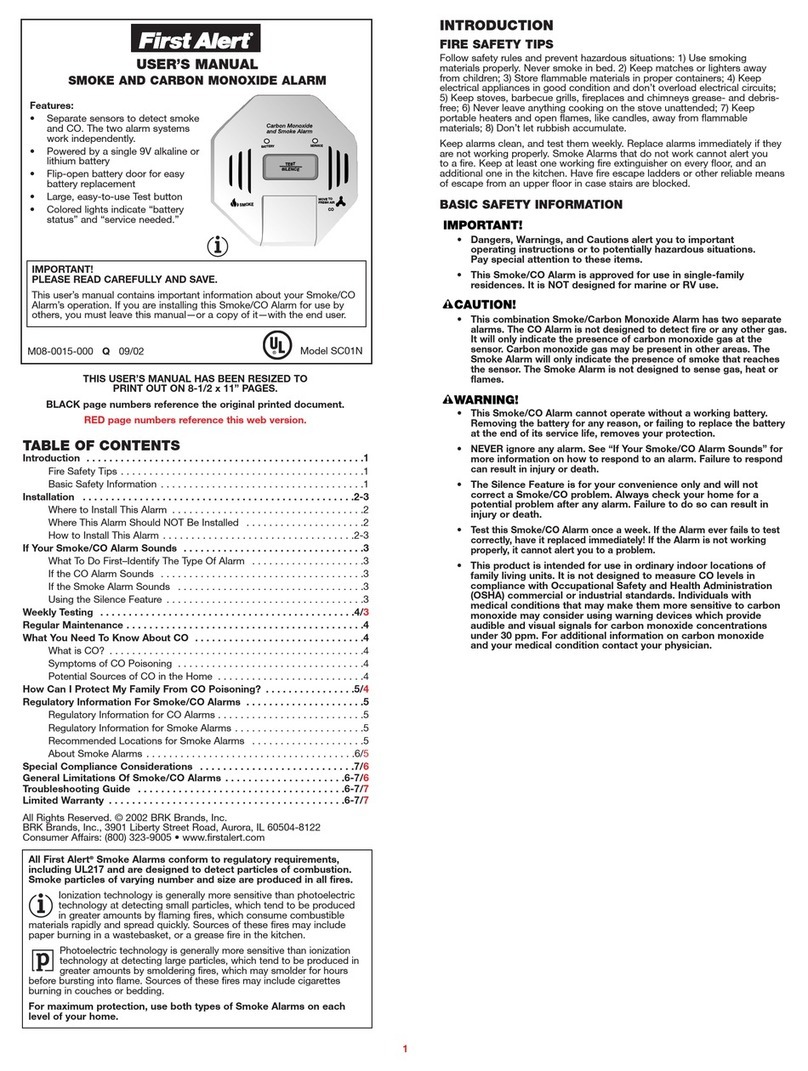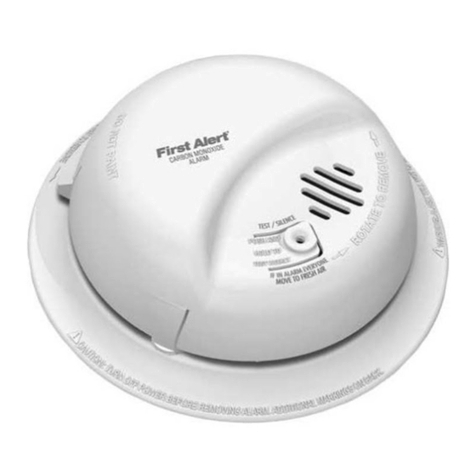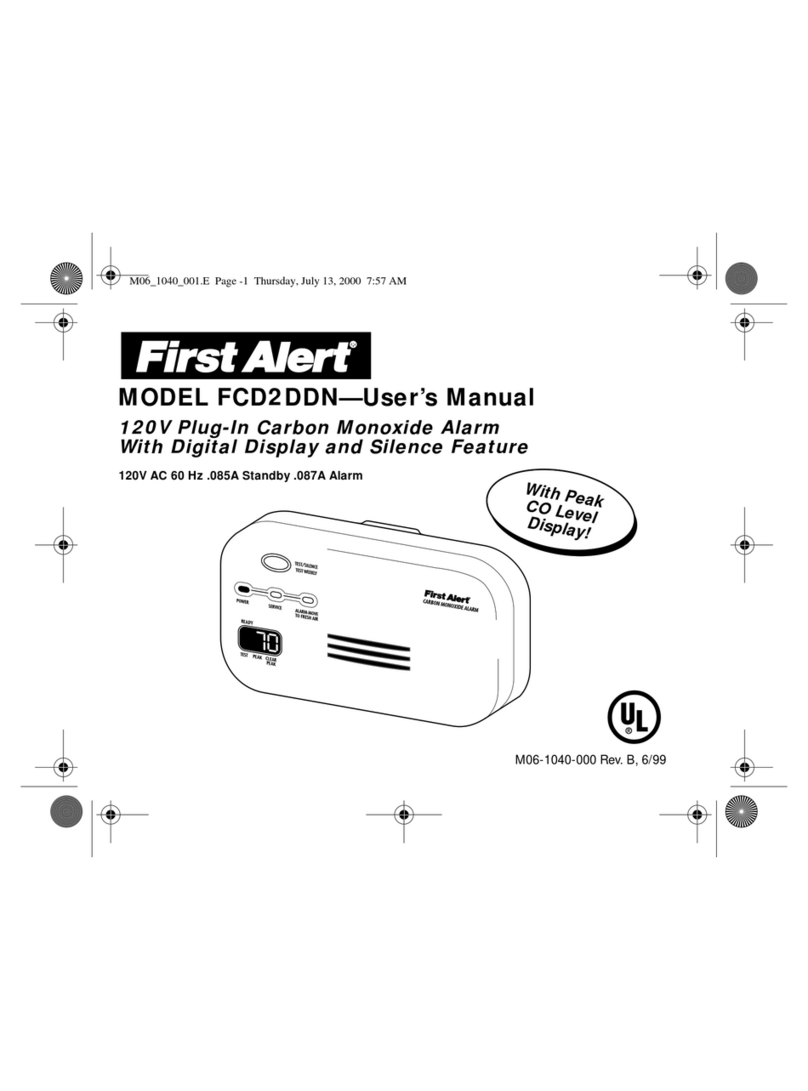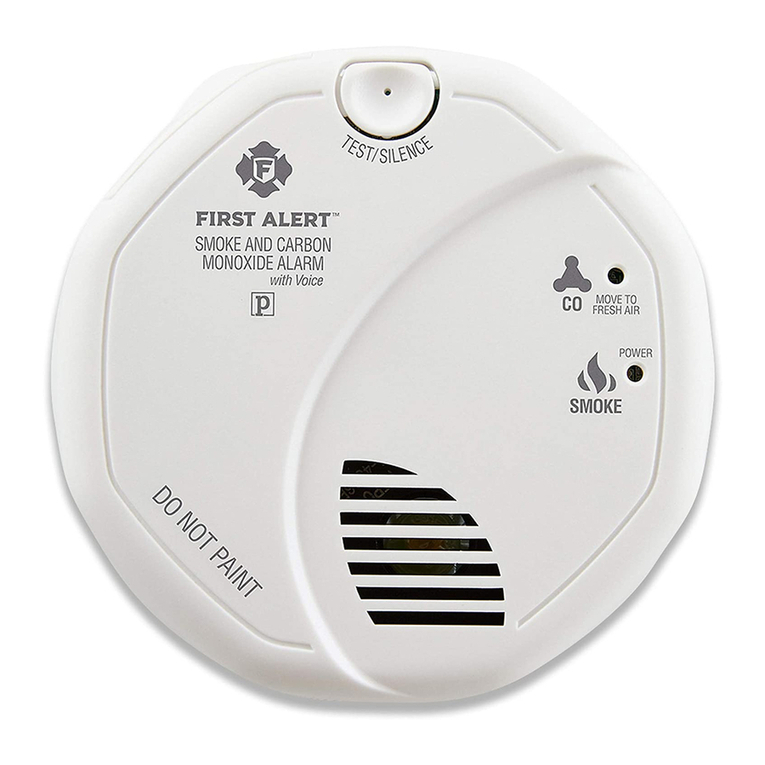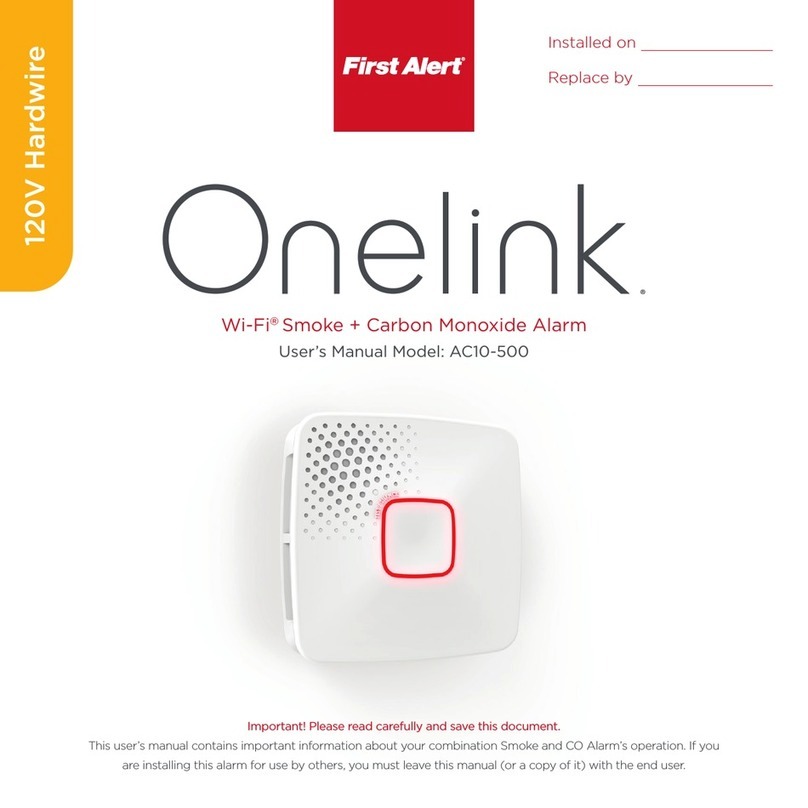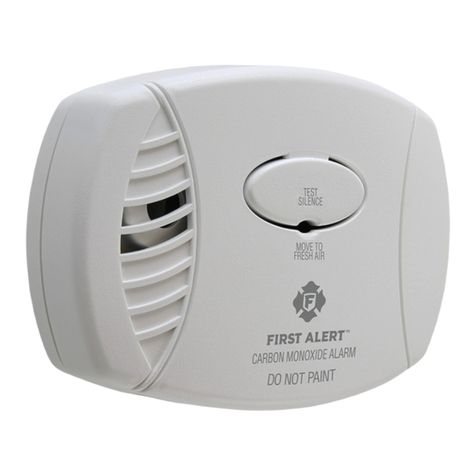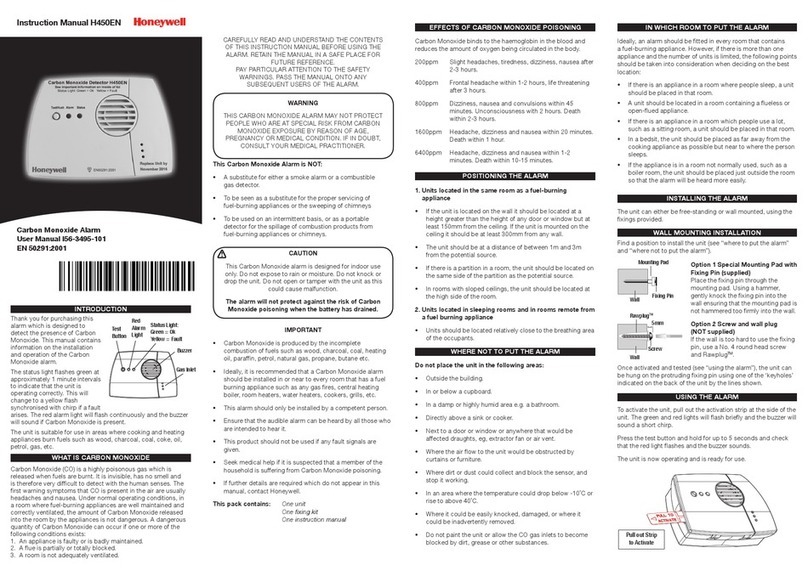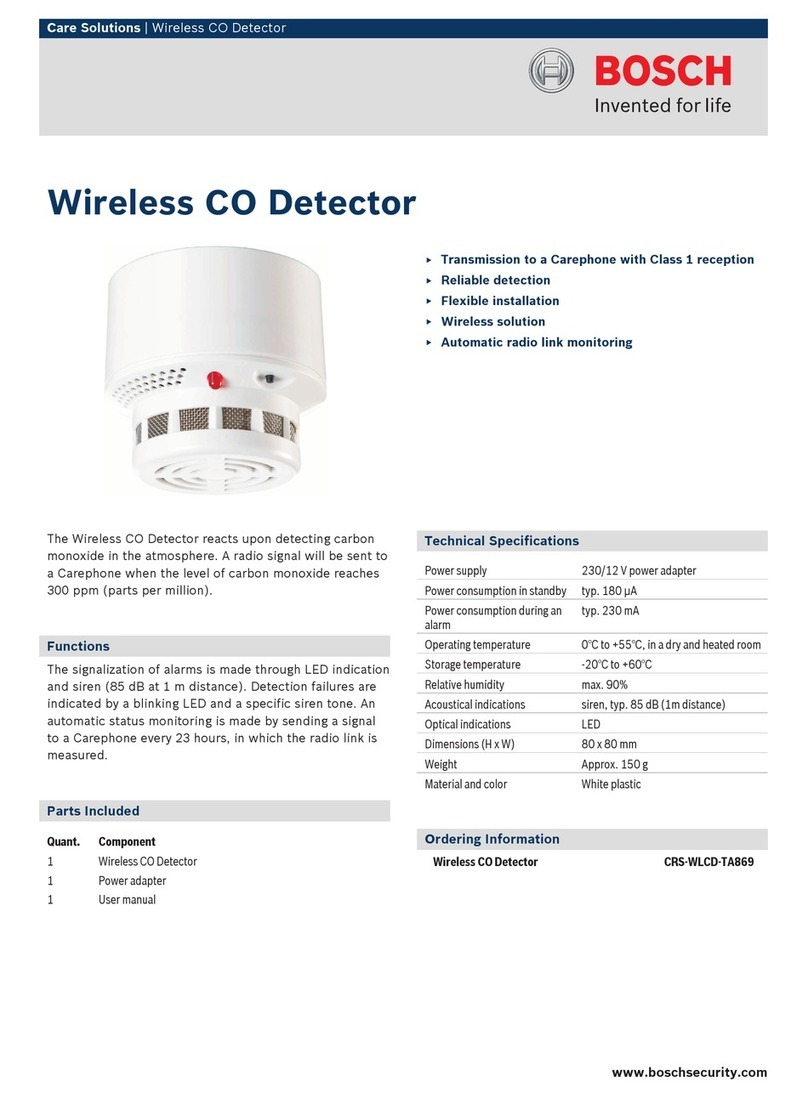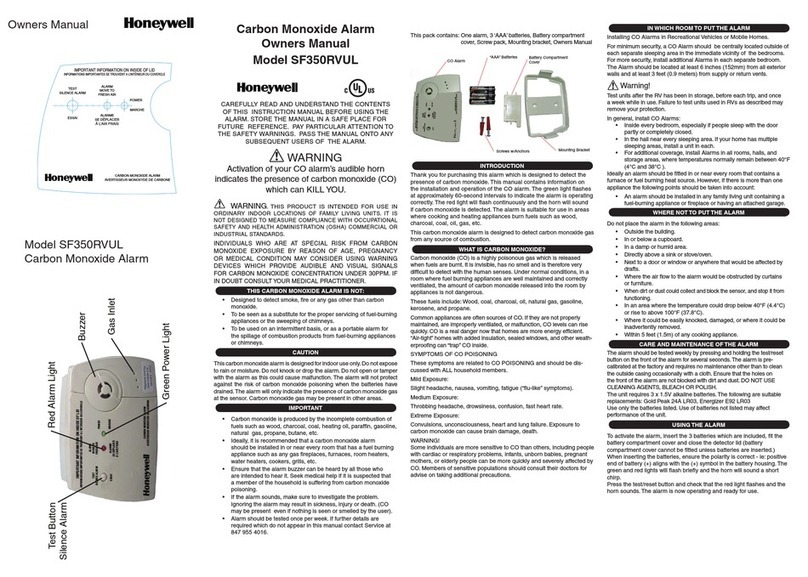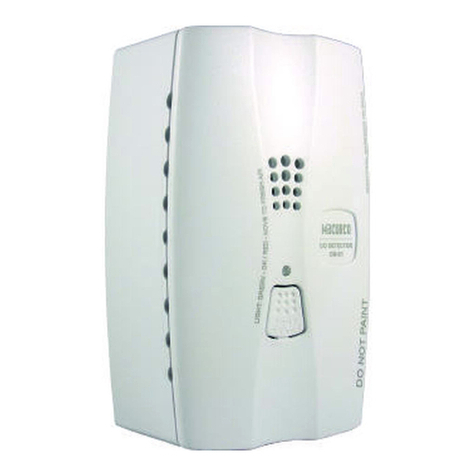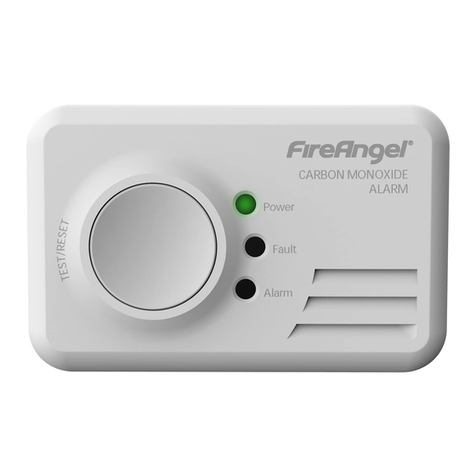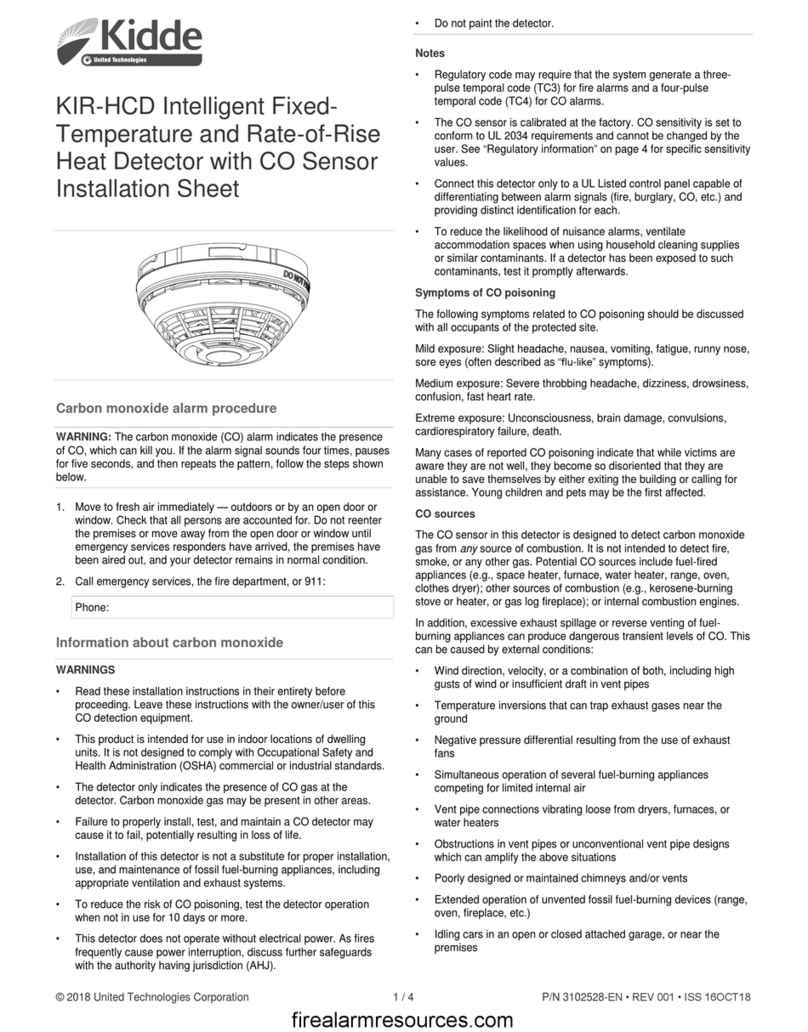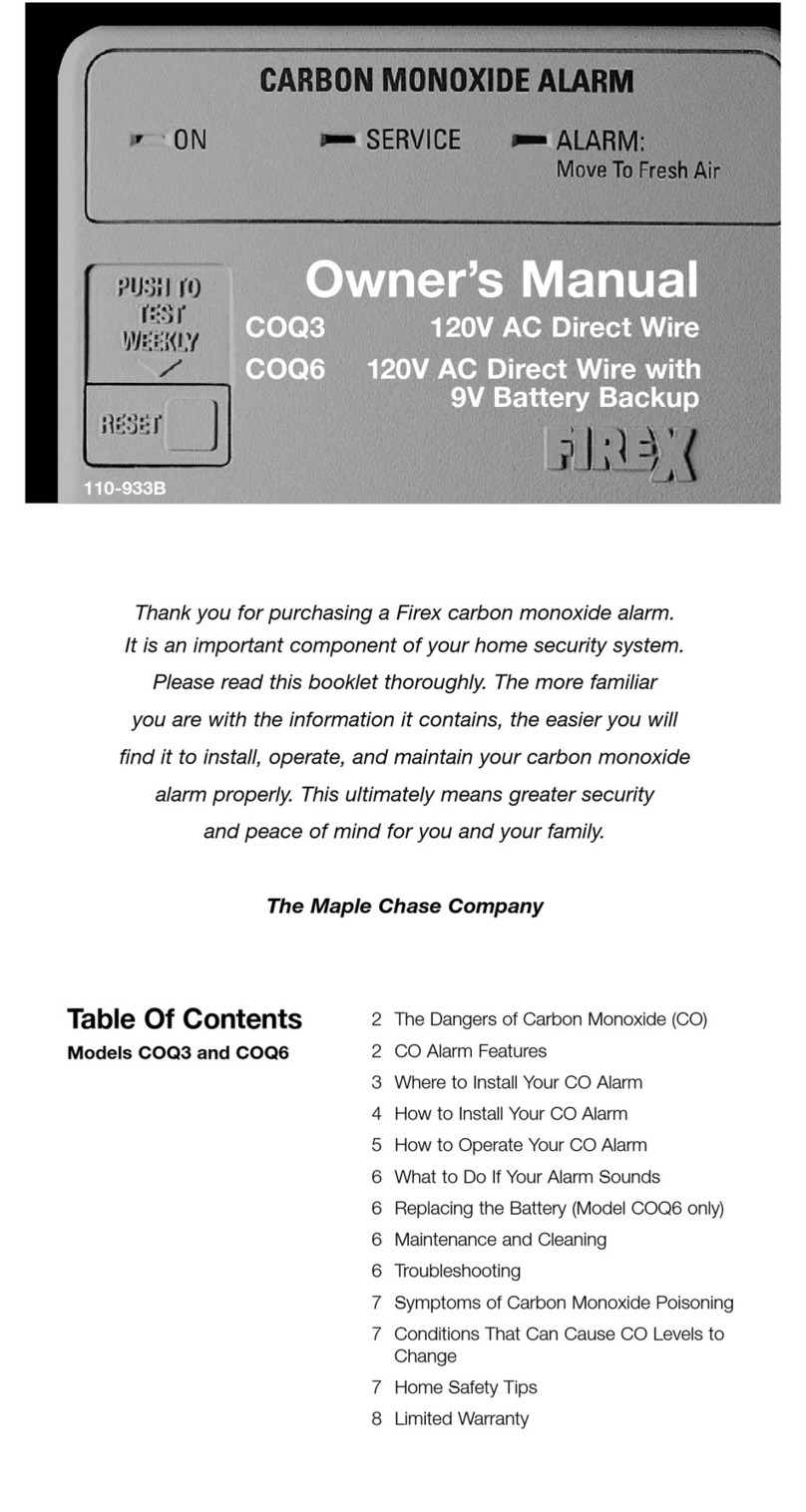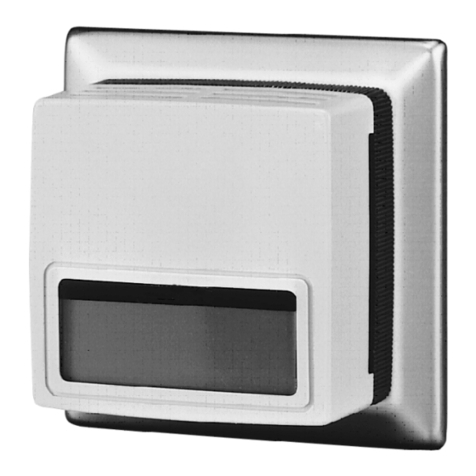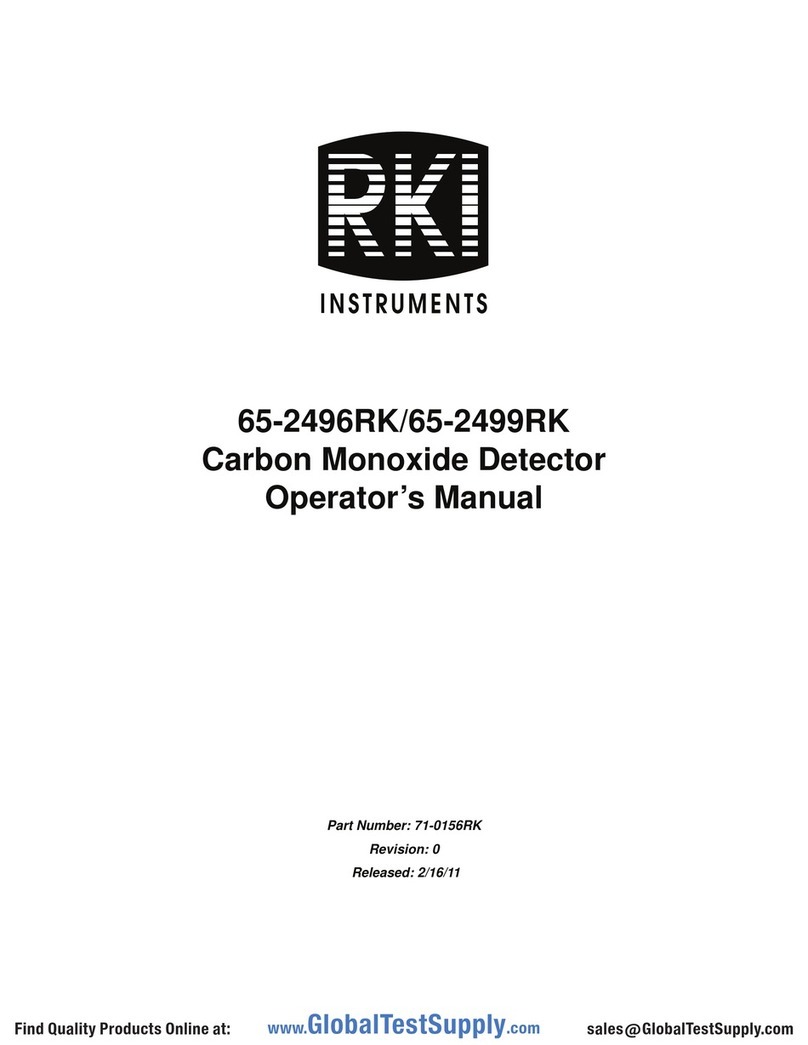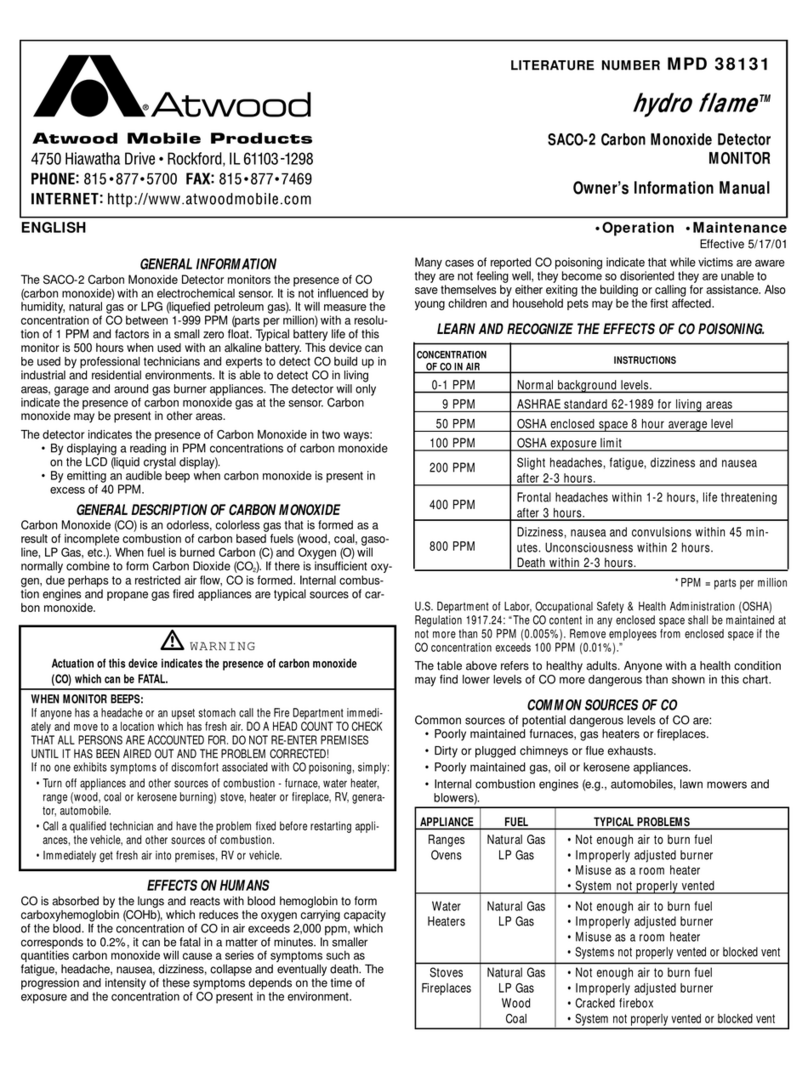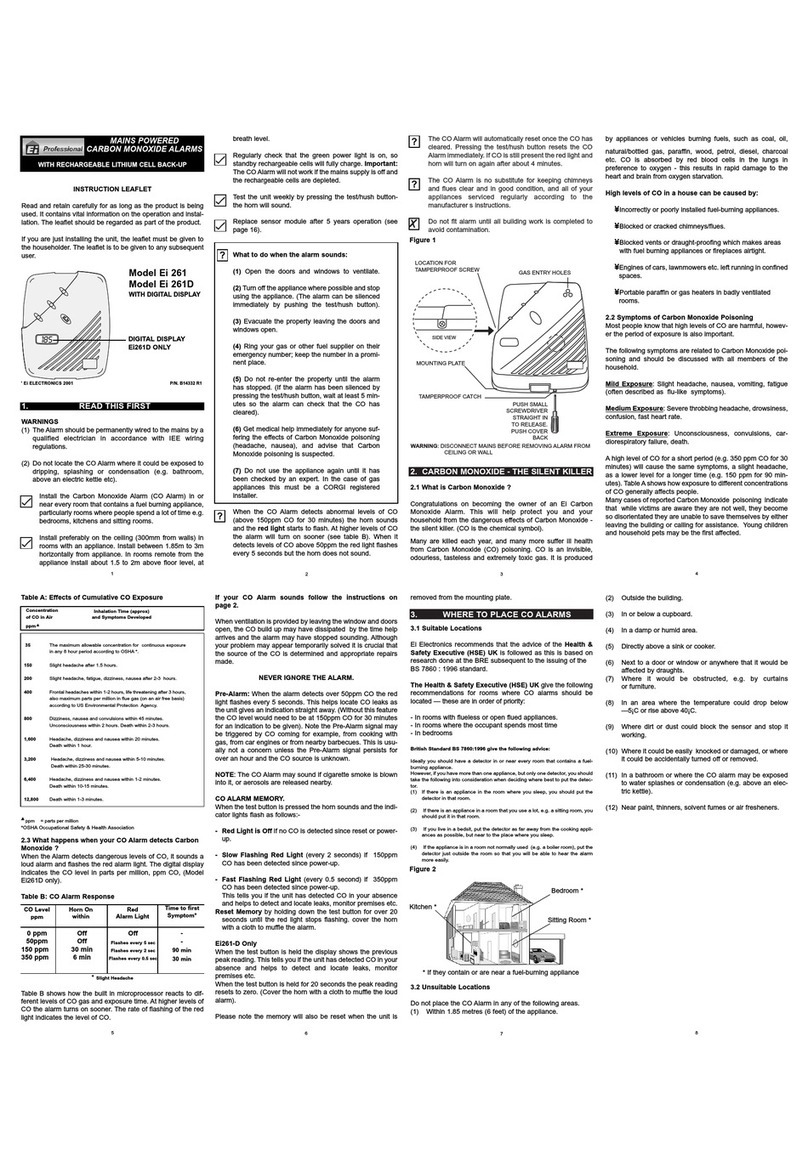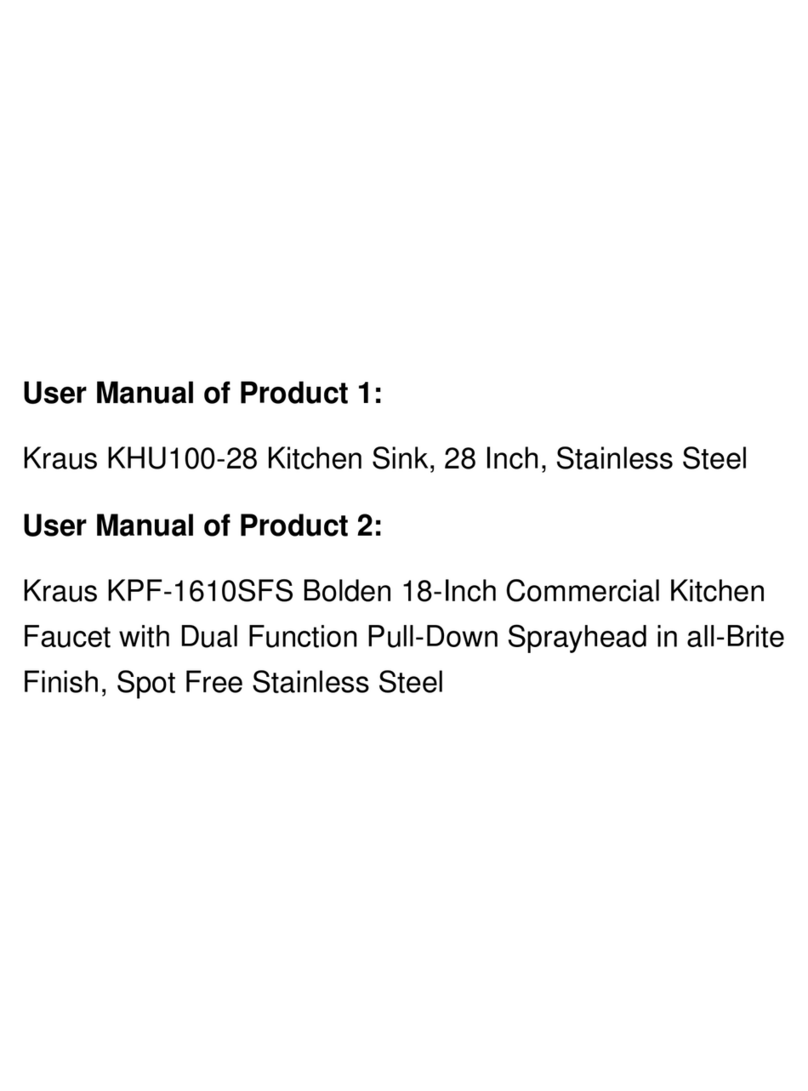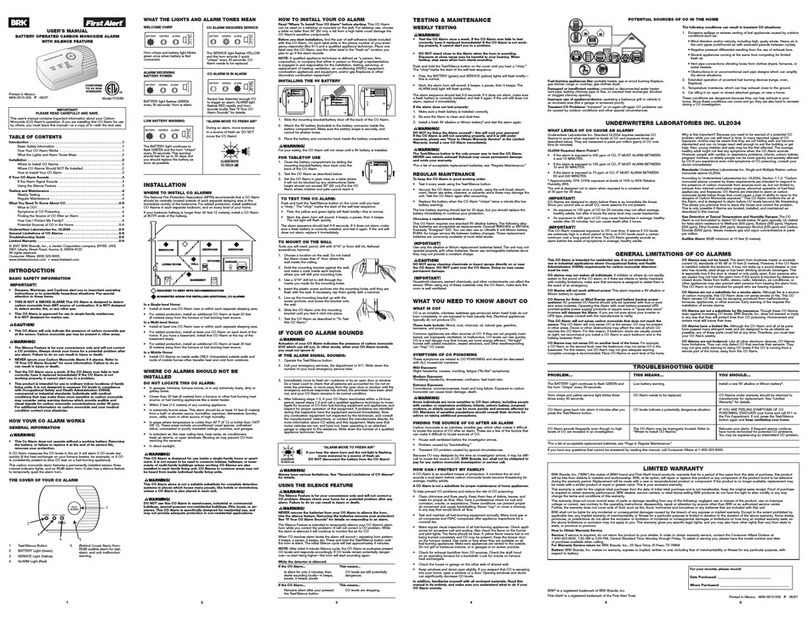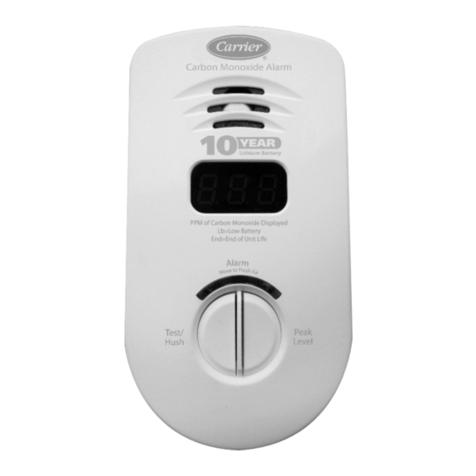INSTALLATION
WHERE TO INSTALL CO ALARMS
The National Building Code of Canada requires carbon monoxide
alarms to be installed inside each bedroom or outside each bed-
room within 5 meters (16.4 feet) of each door. Provincial and local
requirements may also apply. Contact the Authority Having
Jurisdiction if you have questions regarding the requirements in
your area.
If your bedroom hallway is longer than 12 meters (40 feet), install a CO
Alarm at BOTH ends of the hallway.
In a Single-level Home:
• Install at least one CO Alarm near or within each separate sleeping
area.
• For added protection, install an additional CO Alarm at least 6 meters
(20 feet) away from the furnace or fuel burning heat source.
In a Multi-level Home:
• Install at least one CO Alarm near or within each separate sleeping
area.
• For added protection, install at least one CO Alarm on each level of
the home.
• For added protection, install an additional CO Alarm at least 6 meters
(20 feet) away from the furnace or fuel burning heat source.
This unit should receive continuous electrical power. Choose an
outlet where it cannot be accidentallyunplugged or switched off by
children. Keep small children away from the unit.Teach them not to
playwith it or unplug it. Explain what the alarms mean.
WHERE CO ALARMS SHOULD NOT BE
INSTALLED
DO NOTLOCATE THIS CO ALARM:
• In garages, kitchens, furnace rooms, or in any extremely dusty, dirty
or greasy areas.
•Closer than 4.6 meters (15 feet) from a furnace or other fuel
burning heat source, or fuel burning appliances like a water heater.
• Within 1.5 meters (5 feet) of any cooking appliance.
• In extremely humid areas.This Alarm should be at least 3 meters
(10 feet) from a bath or shower, sauna, humidifier, vaporizer, dish-
washer, laundry room, utility room or other source of high humidity.
•In areas where temperature is colder than 4.4OC(40OF) or hotter
than 37.8OC(100OF).These areas include non-airconditioned crawl
spaces,unfinished attics,uninsulated or poorly insulated ceilings,
porches,and garages.
• In turbulent air, like near ceiling fans, heat vents, air conditioners,
fresh air returns, or open windows. Blowing air may prevent CO
from reaching the sensors.
• In direct sunlight.
•In outlets covered bycurtains or other obstruction.
• This CO Alarm is designed for use inside a single-family home
or apartment. It is not meant to be used in common lobbies,
hallways, or basements of multi-family buildings unless working
CO Alarms are also installed in each family living unit.
CO Alarms in common areas may not be heard from inside
individual family living units.
• This CO Alarm alone is not a suitable substitute for complete
detection systems in places which house many people, like
hotels or dormitories, unless a CO Alarm is also placed in each
unit.
•DO NOT use this CO Alarm in warehouses, industrial or com-
mercial buildings, special-purpose non-residential buildings, or
airplanes.This CO Alarm is specifically designed for residential
use, and may not provide adequate protection in non-residential
applications.
USER’S MANUAL
120V PLUG-IN CARBON MONOXIDE ALARM
WITH SILENCE FEATURE
Model
CO600A
Printed in Mexico M08-0210-001 S12/10
IMPORTANT!
PLEASE READ CAREFULLY AND SAVE.
This user’s manual contains important information about your Carbon
Monoxide (CO) Alarm’s operation. If you are installing this CO Alarm for
use by others, you must leave this manual—or a copy of it—with the
end user.
TABLE OF CONTENTS
Introduction . . . . . . . . . . . . . . . . . . . . . . . . . . . . . . . . . . . . . . . . . . . . . .1
Basic Safety Information . . . . . . . . . . . . . . . . . . . . . . . . . . . . . . .1
HowYour CO Alarm Works . . . . . . . . . . . . . . . . . . . . . . . . . . . . .1
Understanding Your CO Alarm . . . . . . . . . . . . . . . . . . . . . . . . . . .2
Installation . . . . . . . . . . . . . . . . . . . . . . . . . . . . . . . . . . . . . . . . . . . . .2-3
Where to Install CO Alarms . . . . . . . . . . . . . . . . . . . . . . . . . . . . .2
Where CO Alarms Should NOT Be Installed . . . . . . . . . . . . . . . .2
How to Install Your CO Alarm . . . . . . . . . . . . . . . . . . . . . . . . . . .3
IfYour CO Alarm Sounds . . . . . . . . . . . . . . . . . . . . . . . . . . . . . . . . . . .3
If the Alarm Signal Sounds . . . . . . . . . . . . . . . . . . . . . . . . . . . . .3
Using the Silence Feature . . . . . . . . . . . . . . . . . . . . . . . . . . . . . .3
Testing and Maintenance . . . . . . . . . . . . . . . . . . . . . . . . . . . . . . . . . . .3
Weekly Testing . . . . . . . . . . . . . . . . . . . . . . . . . . . . . . . . . . . . . . .3
Regular Maintenance . . . . . . . . . . . . . . . . . . . . . . . . . . . . . . . . . .3
WhatYou Need To Know About CO . . . . . . . . . . . . . . . . . . . . . . . . . .4
What is CO? . . . . . . . . . . . . . . . . . . . . . . . . . . . . . . . . . . . . . . . .4
Symptoms of CO Poisoning . . . . . . . . . . . . . . . . . . . . . . . . . . . . .4
Finding the Source of CO After an Alarm . . . . . . . . . . . . . . . . . .4
Potential Sources Of CO In The Home . . . . . . . . . . . . . . . . . . . .4
How Can I Protect My Family? . . . . . . . . . . . . . . . . . . . . . . . . . .4
Regulatory Information for CO Alarms . . . . . . . . . . . . . . . . . . . . . .5-6
General Limitations Of CO Alarms . . . . . . . . . . . . . . . . . . . . . . . . .5-6
Troubleshooting Guide . . . . . . . . . . . . . . . . . . . . . . . . . . . . . . . . . . .5-6
Limited Warranty . . . . . . . . . . . . . . . . . . . . . . . . . . . . . . . . . . . . . . . .5-6
©2010 BRK Brands, Inc. All rights reserved.
Distributed by BRK Brands, Inc.
3901 Liberty Street Road, Aurora, IL 60504-8122 U.S.A.
Consumer Affairs: (800) 323-9005 • www.firstalert.ca
INTRODUCTION
BASIC SAFETY INFORMATION
• Dangers,Warnings, and Cautions alert you to important
operating instructions or to potentially hazardous situations.
Pay special attention to these items.
•THIS IS NOTASMOKE ALARM! This CO Alarm is designed to
detect carbon monoxide from ANY source of combustion. It is
NOTdesigned to detect smoke,fire,or anyother gas.
• This CO Alarm is approved for use in single-family residences.
• This CO Alarm will only indicate the presence of carbon
monoxide gas at the sensor. Carbon monoxide gas may be
present in other areas.
• The Silence Feature is for your convenience only and will not
correct a CO problem. Always check your home for a potential
problem after any alarm. Failure to do so can result in injury or
death.
•This CO Alarm should receive continuous 120VAC, 60 Hz, pure
sine wave electrical power. Do not use in an extension cord or
outlet controlled by a dimmer or switch.
• NEVER ignore your Carbon Monoxide Alarm if it alarms. Refer
to “IfYour CO Alarm Sounds” for more information. Failure to
do so can result in injury or death.
• Test the CO Alarm once a week. If the CO Alarm ever fails to
test correctly, have it replaced immediately! If the CO Alarm is
not working properly, it cannot alert you to a problem.
•This product is intended for use in ordinary indoor locations
of familyliving units. It is not designed to measure CO levels
in compliance with commercial or industrial standards.
Individuals with medical conditions that maymake them more
sensitive to carbon monoxide may consider using warning
devices which provide audible and visual signals for carbon
monoxide concentrations under 30 ppm.This device is
designed to protect individuals from the acute effects of
carbon monoxide exposure. It will not fully safeguard individu-
als with specific medical conditions. If in doubt consult a med-
ical practitioner.
HOWYOUR CO ALARM WORKS
GENERAL INFORMATION
Leave your CO Alarm plugged in year-round. CO problems can
occur anytime during the year, and this Alarm can only alert you if
it is plugged in and receiving power.
When fully powered, the unit samples the air and takes a new reading
about every second. A microchip inside the unit stores each reading,
and remembers the levels of CO it has been exposed to over time.
The Alarm sounds when it has been exposed to a “critical” level of CO
(measured in parts per million or “ppm”) within a specified time (meas-
ured in minutes).This CO Alarm features a permanently installed sensor,
an indicator light, and an 85 dB alarm horn. It also has a Silence Feature
to temporarily quiet the alarm horn.
MALFUNCTION WARNING
This unit performs daily self-diagnostic tests. If the Alarm malfunctions, it
should be replaced immediately.
THE COVER OFYOUR CO ALARM
12345
LIMITED WARRANTY
BRK Brands, Inc. ("BRK") the maker of First Alert®brand products, warrants that for a period of 7 years from the date of purchase, this product
will be free from defects in material and workmanship. BRK, at its option, will repair or replace this product or any component of the product
found to be defective during the warranty period. Replacement will be made with a new or remanufactured product or component. If the
product is no longer available, replacement may be made with a similar product of equal or greater value This is your exclusive warranty.
This warranty is valid for the original retail purchaser from the date of initial retail purchase and is not transferable. Keep the original sales
receipt. Proof of purchase is required to obtain warranty performance. BRK dealers, service centers, or retail stores selling BRK products do
not have the right to alter, modify or any way change the terms and conditions of this warranty.
This warranty does not cover normal wear of parts or damage resulting from any of the following: negligent use or misuse of the product, use
on improper voltage or current, use contrary to the operating instructions, disassembly, repair or alteration by anyone other than BRK or an
authorized service center. Further, the warranty does not cover acts of God, such as fire, flood, hurricanes and tornadoes or any batteries that
are included with this unit.
BRK shall not be liable for any incidental or consequential damages caused by the breach of any express or implied warranty. Except to the
extent prohibited by applicable law, any implied warranty of merchantability or fitness for a particular purpose is limited in duration to the
duration of the above warranty. Some states, provinces, or jurisdictions do not allow the exclusion or limitation of incidental or consequential
damages or limitations on howlong an implied warranty lasts, so the above limitations or exclusion may not apply to you.This warranty gives
you specific legal rights, and you may also have other rights that vary from state to state, or province to province.
Howto Obtain Warranty Service
Service: If service is required, do not return the product to your retailer. In order to obtain warranty service, contact the Consumer Affairs
Division at 1-800-323-9005, 7:30 AM to 5:00 PM, Central Standard Time,Mondaythrough Friday.To assist in serving you, please have the
model number and date of purchase available when calling.
For Warranty Service return to: BRK Brands, Inc., 25 Spur Drive, El Paso, TX 79906
6
1. Test/Silence Button 2. POWER/ALARM Light (Red)
3. (Behind Cover) Alarm Horn: 85 dB audible alarm
for test, alarm, and unit malfunction warning
UNDERSTANDING YOUR CO ALARM
WHAT YOU SEE AND HEAR DURING INSTALLATION
HOW TO INSTALL YOUR CO ALARM
Read “WhereTo Install CO Alarms” before starting.
1. Plug the unit into a standard UNSWITCHED 120V AC outlet.
The unit should be located
where it can wake you if it
alarms at night.
2. Make sure the POWER/ALARM light
shines continuously when
you plug it.
3. Test by pressing the Test/Silence button
firmly until the unit sounds: four loud
beeps, pause, 4 beeps. During testing,
the POWER/
ALARM light will flash rapidly. This is normal.
USING THE SILENCE FEATURE
The Silence Feature is for your convenience only and will not cor-
rect a CO problem. Always check your home for a potential problem
after any alarm. Failure to do so can result in injury or death.
NEVER unplug your CO Alarm to silence the horn. Use the silence
feature. Unplugging the CO Alarm removes your protection! See “If
Your CO Alarm Sounds” for details on responding to an alarm.
When CO reaches alarm levels the alarm will sound— repeating horn
pattern: 4 beeps, a pause, 4 beeps, etc. Press and hold the Test/Silence
button until the horn is silent.The initial Silence cycle will last approxi-
mately 4 minutes.
NOTE: After initial 4-minute Silence cycle, the CO Alarm re-evaluates
present CO levels and responds accordingly. If CO levels remain poten-
tially dangerous—or start rising higher—the horn will start sounding
again.
While the detector is silenced:
WHATYOU NEED TO KNOW ABOUT CO
WHAT IS CO?
CO is an invisible, odorless, tasteless gas produced when fossil fuels
do not burn completely, or are exposed to heat (usually fire). Electrical
appliances typically do not produce CO.
These fuels include: Wood, coal, charcoal, oil, natural gas, gasoline,
kerosene, and propane.
Common appliances are often sources of CO. If they are not properly
maintained, are improperly ventilated, or malfunction, CO levels can rise
quickly. CO is a real danger now that homes are more energy efficient.
“Air-tight” homes with added insulation, sealed windows, and other
weatherproofing can “trap” CO inside.
SYMPTOMS OF CO POISONING
These symptoms are related to CO POISONING and should be
discussed with ALL household members.
Mild Exposure:
Headaches, running nose, sore eyes, often described as "flu"-like
symptoms.
Medium Exposure:
Dizziness, drowsiness, vomiting.
Extreme Exposure:
Unconsciousness, brain damage, death.
Some individuals are more sensitive to CO than others, including
people with cardiac or respiratory problems, infants, unborn
babies, pregnant mothers, or elderly people can be more quickly
and severely affected by CO. Members of sensitive populations
should consult their doctors for advice on taking additional
precautions.
FINDING THE SOURCE OF CO AFTER AN ALARM
Carbon monoxide is an odorless, invisible gas, which often makes it
difficult to locate the source of CO after an alarm. These are a few of the
factors that can make it difficult to locate sources of CO:
• House well ventilated before the investigator arrives.
• Problem caused by “backdrafting.”
• Transient CO problem caused by special circumstances.
Because CO may dissipate by the time an investigator arrives, it may be
difficult to locate the source of CO. BRK Brands, Inc. shall not be obli-
gated to pay for any carbon monoxide investigation or service call.
POTENTIAL SOURCES OF CO IN THE HOME
Fuel-burning appliances like: portable heater, gas or wood burning
fireplace, gas kitchen range or cooktop, gas clothes dryer.
Damaged or insufficient venting: corroded or disconnected water
heater vent pipe,leaking chimneypipe or flue, or cracked heat exchang-
er,blocked or clogged chimney opening.
Improper use of appliance/device: operating a barbecue grill or
vehicle in an enclosed area (like a garage or screened porch).
Transient CO Problems: “transient” or on-again-off-again CO problems
can be caused byoutdoor conditions and other special circumstances.
The following conditions can result in transient CO situations:
1. Excessive spillage or reverse venting of fuel appliances caused by
outdoor conditions such as:
•Wind direction and/or velocity, including high, gusty winds. Heavy
air in the vent pipes (cold/humid air with extended periods
between cycles).
•Negative pressure differential resulting from the use of exhaust
fans.
•Several appliances running at the same time competing for limited
fresh air.
•Vent pipe connections vibrating loose from clothes dryers,
furnaces, or water heaters.
•Obstructions in or unconventional vent pipe designs which can
amplify the above situations.
2. Extended operation of unvented fuel burning devices (range, oven,
fireplace).
3. Temperature inversions, which can trap exhaust close to the ground.
4. Car idling in an open or closed attached garage, or near a home.
These conditions are dangerous because they can trap exhaust in your
home. Since these conditions can come and go, they are also hard to
recreate during a CO investigation.
HOWCAN I PROTECT MY FAMILY?
ACO Alarm is an excellent means of protection. It monitors the air and
sounds a loud alarm before carbon monoxide levels become threatening
for average, healthy adults.
ACO Alarm is not a substitute for proper maintenance of home
appliances.
Tohelp prevent CO problems and reduce the risk of CO poisoning:
• Clean chimneys and flues yearly. Keep them free of debris, leaves,
and nests for proper air flow. Also, have a professional check for
rust and corrosion, cracks, or separations.These conditions can
prevent proper air movement and cause backdrafting. Never “cap” or
cover a chimney in any way that would block air flow.
• Test and maintain all fuel-burning equipment annually. Many
local gas or oil companies and HVAC companies offer appliance
inspections for a nominal fee.
• Make regular visual inspections of all fuel-burning appliances.
Check appliances for excessive rust and scaling. Also check the
flame on the burner and pilot lights.The flame should be blue.
A yellow flame means fuel is not being burned completely and CO
may be present. Keep the blower door on the furnace closed. Use
vents or fans when they are available on all fuel-burning appliances.
Make sure appliances are vented to the outside. Do not grill or
barbecue indoors, or in garages or on screen porches.
•Check for exhaust backflowfrom CO sources.Check the draft hood
on an operating furnace for a backdraft. Look for cracks on furnace
heat exchangers.
• Check the house or garage on the other side of shared wall.
•Keep windows and doors open slightly.If you suspect that CO is
escaping into your home,open a windowor a door.Opening
windows and doors can significantly decrease CO levels.
In addition, familiarize yourself with all enclosed materials. Read
this manual in its entirety, and make sure you understand what to
do if your CO Alarm sounds.
WHAT LEVELS OF CO CAUSE AN ALARM?
Canadian Standards Association 6.19-01 requires residential CO
Alarms to sound when exposed to levels of CO and exposure times as
described below. CO levels are measured in parts per million (ppm) of
CO over time (in minutes).
CSA 6.19-01 Required Alarm Points*:
• If the alarm is exposed to 400 ppm of CO, IT MUST ALARM
BETWEEN 4 and 15 MINUTES
•If the alarm is exposed to 150 ppm of CO, IT MUST ALARM
BETWEEN 10 and 50 MINUTES.
•If the alarm is exposed to 70 ppm of CO, IT MUST ALARM
BETWEEN 60 and 240 MINUTES.
*Approximately 10% COHb exposure at levels of 10% to 95% Relative
Humidity (RH).
The unit is designed not to alarm when exposed to a constant level
of30 ppm for 30 days.
COAlarms are designed to alarm before there is an immediate life
threat. Since you cannot see or smell CO, never assume it’s not present.
• An exposure to 100 ppm of CO for 20 minutes may not affect
average, healthy adults, but after 4 hours the same level may
cause headaches.
• An exposure to 400 ppm of CO may cause headaches in average,
healthy adults after 35 minutes, but can cause death after 2 hours.
This CO Alarm measures exposure to CO over time. It alarms if CO
levels are extremely high in a short period of time, or if CO levels reach
acertain minimum over a long period of time.The CO Alarm generally
sounds an alarm before the onset of symptoms in average, healthy
adults.
TESTING AND MAINTENANCE
WEEKLY TESTING
Press the Test/Silence button on the Alarm cover until alarm sounds.
During testing, you will hear a loud alarm sequence – 4 beeps, pause,
4beeps, pause.
The alarm sequence should last 5-6 seconds. If it does not alarm, make
sure the unit is fully plugged into an unswitched outlet. If the unit still
does not alarm, replace it immediately.
•If the Alarm ever fails to test properly, replace it immediately.
Products under warranty may be returned to the manufacturer
for replacement. See “Limited Warranty” at the end of this
manual.
•DO NOT stand close to the Alarm when the horn is sounding.
Exposure at close range may be harmful to your hearing.When
testing, step away when horn starts sounding.
• NEVER use vehicle exhaust! Exhaust may cause permanent
damage and voids your warranty.
REGULAR MAINTENANCE
Tokeep the CO Alarm working properly:
• Test it every week as described in “Weekly Testing.”
• Vacuum the CO Alarm cover at least once a month, using the soft
brush attachment. Never use water, cleaners, or solvents, since they
may damage the unit. Test the Alarm again after vacuuming.
DO NOT spray cleaning chemicals or insect sprays directly on or
near the CO Alarm. DO NOT paint over the CO Alarm. Doing so may
cause permanent damage.
• Household cleaners, aerosol chemicals and other contaminants can
affect the sensor. When using any of these materials near the CO
Alarm, make sure the room is well ventilated.
• If your home is being fumigated, unplug the unit temporarily and
put it where it will not be exposed to chemicals or fumes.When
fumigation is complete and all traces of fumes clear, plug the unit
back in and retest it.
This CO Alarm is intended for residential use. It is not intended for
use in industrial applications where Occupational Safety and Health
Administration (OSHA) requirements for carbon monoxide detec-
tors must be met.
COalarms may not waken all individuals. If children or others do not
readily waken to the sound of the CO alarm, or if there are infants or
family members with mobility limitations, make sure that someone is
assigned to assist them in the event of an emergency.
CO Alarms will not work without power. This CO Alarm requires a
continuous supply of AC power. Plug into an unswitched 120V AC outlet
only.
CO Alarms for Solar or Wind Energy users and battery backup
power systems: AC powered CO Alarms should only be operated with
true or pure sine wave inverters. Operating this CO Alarm with most
battery-powered UPS (uninterruptible power supply) products or square
wave or “quasi sine wave” inverters will damage the Alarm. If you are
not sure about your inverter or UPS type, please consult with the manu-
facturer to verify.
This CO Alarm will not sense carbon monoxide that does not reach
the sensor. This CO Alarm will only sense CO at the sensor. CO may be
present in other areas. Doors or other obstructions may affect the rate at
which CO reaches the CO Alarm. For this reason, if bedroom doors are
usually closed at night, we recommend you install a CO Alarm in each
bedroom and in the hallway between them.
CO Alarms may not sense CO on another level of the home. For
example, a CO Alarm on the second level, near the bedrooms, may not
sense CO in the basement. For this reason, one CO Alarm may not give
adequate warning. Complete coverage is recommended. Place CO
Alarms on each level of the home.
CO Alarms may not be heard. The alarm horn loudness meets or
exceeds current standards of 85 dB at 3 meters (10 feet). However,
if the CO Alarm is installed outside the bedroom, it may not wake up a
sound sleeper or one who has recently used drugs or has been drinking
alcoholic beverages. This is especially true if the door is closed or only
partly open. Even persons who are awake may not hear the alarm horn
if the sound is blocked by distance or closed doors. Noise from traffic,
stereo, radio, television, air conditioner, or other appliances may also
prevent alert persons from hearing the alarm horn.This CO Alarm is
not intended for people who are hearing impaired.
COAlarms are not a substitute for a smoke alarm. Although fire is a
source of carbon monoxide, this CO Alarm does not sense smoke or fire.
This CO Alarm senses CO that may be escaping unnoticed from mal-
functioning furnaces, appliances, or other sources. Early warning of fire
requires the installation of smoke alarms.
CO Alarms are not a substitute for life insurance. Though these CO
Alarms warn against increasing CO levels, BRK Brands, Inc. does not
warrant or imply in any way that they will protect lives from CO poisoning.
Homeowners and renters must still insure their lives.
CO Alarms have a limited life. Although the CO Alarm and all of its
parts have passed many stringent tests and are designed to be as
reliable as possible, any of these parts could fail at any time.Therefore,
you must test your CO Alarm weekly.
CO Alarms are not foolproof. Like all other electronic devices, CO
Alarms have limitations.They can only detect CO that reaches their
sensors.They may not give early warning to rising CO levels if the CO
is coming from a remote part of the home, away from the CO Alarm.
TROUBLESHOOTING GUIDE
PROBLEM... THIS MEANS... YOU SHOULD...
Red light is OFF. Unit will not alarm when you
press the Test/Silence button. CO Alarms may not be plugged all the way in, or
is not receiving power. Gently push unit all the way into outlet. Make sure
it is not plugged into an outlet controlled by a
switch.
The light flashes (RED) and the horn sounds 3
quick “chirps” every minute. MALFUNCTION SIGNAL. CO Alarm needs to be
replaced. Make sure unit is plugged in securely.
CO Alarms under warranty should be returned
to manufacturer for replacement. See “Limited
Warranty” for details.
CO Alarm goes back into alarm 4 minutes after
you press the Test/Silence button. CO levels indicate a potentially dangerous
situation. IF YOU ARE FEELING SYMPTOMS OF CO
POISONING, EVACUATE your home and call 911
or the Fire Department. If not, press the Test/
Silence button again and keep ventilating your
home.
CO Alarm sounds frequently even though no high
levels of CO are revealed in an investigation. The CO Alarm may be improperly located.
Refer to “Where to Install CO Alarms.” Relocate your Alarm. If frequent alarms continue,
have home rechecked for potential CO problems.
You may be experiencing an intermittent CO prob-
lem.
If you have any questions that cannot be answered by reading this manual, call Consumer Affairs at 1-800-323-9005.
120V AC ~,
60Hz, 0.09A
Why is this important? Because you need to be warned of a potential
CO problem while you can still react in time. In many reported cases of
CO exposure, victims may be aware that they are not feeling well, but
become disoriented and can no longer react well enough to exit the
building or get help. Also, young children and pets may be the first affect-
ed.The average healthy adult might not feel any symptoms when the
CO Alarm sounds. However, people with cardiac or respiratory
problems, infants, unborn babies, pregnant mothers, or elderly people
can be more quickly and severely affected by CO. If you experience
even mild symptoms of CO poisoning, consult your doctor immediately!
Standards: Canadian Standards Association 6.19-01.
Many cases of reported CARBON MONOXIDE POISONING indicate
that while victims are aware they are not well, they become so
disoriented they are unable to save themselves by either exiting the
building or calling for assistance.
Gas Detection at Typical Temperature and Humidity Ranges: The
CO Alarm is not formulated to detect CO levels below 30 ppm typically.
Tested for false alarm resistance to Methane (500 ppm), Butane (300
ppm), Heptane (500 ppm), Ethyl Acetate (200 ppm), Isopropyl Alcohol
(200 ppm) and Carbon Dioxide (5000 ppm). Values measure gas and
vapor concentrations in parts per million.
Audible Alarm: 85 dB minimum at 3 meters (10 feet).
REGULATORY INFORMATION FOR CO ALARMS
GENERAL LIMITATIONS OF CO ALARMS
First Alert®is a registered trademark of the First Alert Trust.
Printed in Mexico M08-0210-001 S12/10
WHENYOU FIRST PLUG-IN THE CO ALARM:
HORN: Silent
POWER/ALARM LIGHT: Shines continuously
UNDER NORMAL CONDITIONS (AC POWER):
HORN: Silent
POWER/ALARM LIGHT: Shines continuously
WHENYOU TEST THE CO ALARM:
HORN: Sounds loudly - 4 beeps, pause, 4 beeps, pause
POWER/ALARM LIGHT: Flashes rapidly
WHAT YOU SEE AND HEAR UNDER DIFFERENT CONDITIONS
WHEN THE ELECTRICITY COMES BACK ON AFTER A POWER
FAILURE:
HORN: Silent
POWER/ALARM LIGHT: Shines continuously.
IFTHE CO ALARM IS NOT OPERATING PROPERLY (MALFUNCTION
SIGNAL):
HORN: Three rapid chirps every minute
POWER/ALARM LIGHT: Flashes three times in sync with the horn.
WHAT YOU SEE AND HEAR IF CO IS DETECTED
ALARM LEVELS OF CO ARE DETECTED:
HORN: Sounds loudly - 4 beeps, pause, 4 beeps, pause.
This sequence repeats for as long as the unit is in alarm.
POWER/ALARM LIGHT: Flashes rapidly
IFYOU SILENCE THE ALARM:
HORN: Silent for about 4 minutes
POWER/ALARM LIGHT: Flashes rapidly
Note: After 4 minutes, if CO levels drop below alarm levels, the unit
will remain silent and return to normal operation. If CO presence still
indicates a potentially dangerous situation, the horn will sound
again.
IF THE CO LEVELS RETURN TO NORMAL:
HORN: Silent
POWER/ALARM LIGHT: Shines continuously
For your records, please record:
Date Purchased: ____________/______________
Where Purchased: ________________________________
Date Installed: ____________/____________Month/Year
Replacement date is seven years after installation:
_____________/____________Month/Year
NOTE: End of Life Signal — Once the unit reaches the end of its
lifecycle, the MALFUNCTION SIGNAL will sound once a minute to
indicate the need to immediatelyreplace the Alarm.
The End-of-LifeSignal can be silenced for up to 2 days.
Do not unplug the alarm until you get a replacement.
The replacement date is the date beyond whichthe device may
no longer detect carbon monoxide accurately and should be
immediately replaced.
Ifthe CO Alarm...
Is silent for only 4 minutes,
then starts sounding loudly—
4beeps,pause,
4beeps,pause
This means...
CO levels are still potentially
dangerous.
If the CO Alarm...
Remains silent after you
pressed the Test/Silence
button
This means...
CO levels are dropping.
2
3
1
ACPlug
CERTIFIED TO
CSA STD 6.19-01
REQUIREDTO MEET CODE RECOMMENDATIONS
SUGGESTED AREAS FOR INSTALLING ADDITIONAL CO ALARMS
SILENCING THE END OF LIFE SIGNAL
This silence feature can temporarily quiet the End of Life warning “chirp”
for up to 2 days.You can silence the End of Life warning “chirp” by
pressing the Test/Silence button.The horn will chirp, acknowledging that
the End of Lifesilence feature has been activated.
After approximately 2 days, the End of Life “chirp” will resume. After
approximately 2-3 weeks the End of Life warning cannot be silenced.
IF THE CO ALARM SOUNDS
Actuation of your CO Alarm indicates the presence of car-
bon monoxide (CO) which can kill you. In other words,
when your CO Alarm sounds, you must not ignore it!
1. Immediately move to fresh air—outdoors or by an open
door or window.Do a head count to check that all persons are
accounted for. Do not re-enter the premises, or move away
from the open door or window until the emergency services
responder has arrived, the premises have been aired out, and
your CO Alarm remains in its normal condition.
2. Call your emergency services, fire department or 911. Write
down the number of your local emergency service here:
_________________________________________________
“ALARM-MOVE TO FRESH AIR”
If you hear the CO alarm horn and the
COred light is flashing,
move everyone to a source of fresh air.
DONOT unplug alarm!

